





We continue stocking up the cottage garden area with meadow saffron – Colchicum autumnale – sometimes wrongly known as autumn crocus. The crocus-like flowers come in August/September, the huge leaves in spring. Plant the corm as soon as you buy it, or put it on a window sill to flower – no earth, no water -then plant out to let it make leaf. Having done turfing earlier, we now prepare a piece of ground for seeding for a lawn in autumn.

Colchicums are the most spectacular plant in flower in the garden in their season. They’re so easy to grow well that the surprising thing is that you don’t see them in every garden. Often known as autumn crocuses, they’re not crocuses at all. Autumn crocuses are true crocuses: colchicums merely look like crocuses: actually they’re first cousins to the lilies, though you’d never guess it to look at them. The great fat corms produce a succession of crocus-like flowers from bare ground in fall. The large strap-shaped leaves follow in spring. The easiest to grow is Colchicum autumnale, but there are other species and varieties with purple or white flowers, and some with double flowers.
Needs list: 3 colchicum corms; 1 pkt compost activator.
Time budget: 1 hour in 1 week
Early September weather/soil
Autumn is arriving rapidly now, announcing itself in a whirl of equinoxial gales, tearing fiery leaves from trees. Starry nights are followed by heavy dews caused by the air being colder than the soil. Good time to plant since roots can get established before the soil cools.
1. Often a hot, dry time of year now, so keep on watering all containers, and essential plants like marrows, tomatoes, pumpkins. Save water when you can. Use washing-up water on marrows/squashes and tomatoes: does the plants no harm, helps to kill soil bugs.
2. Pinch out growing tips of marrows/squashes and tomatoes to keep plants compact and help fruits to form.
3. Check for wallflower seedlings around the garden, identify them, mark them with stakes to move later if you want to.
4. Work a good layer of peat into the surface of the soil in the dahlia and chrysanthemum bed: if it’s very dry, soak first.
5. Learn about a few more friends and enemies. Dogs and cats may be your best friends, but they’re not your garden’s best friends. Learn to control them. The British hedgehog is definitely a garden’s good friend. As is America’s praying mantis. They have a voracious appetite for insects. Don’t try to tame a hedgehog. If you do it’s very likely it may emerge prematurely from hibernation, and that could kill it. In America you can buy the large egg-cases of praying mantis to hatch in the garden.
Two Hour Gardening Project: Stage 26 Climbing Plants and Pergolas
Two Hour Gardening Project: Stage 24 Propagation and Growing Herbs
Two Hour Gardening Project: Stage 23 Principles of Pruning
Two Hour Gardening Project: Stage 21 Making Christmas Present Plants
Two Hour Gardening Project: Stage 20 Tubs and Container Gardening
Two Hour Gardening Project: Stage 18 Choosing Shrubs for the Garden
Two Hour Gardening Project: Stage 17 Fan Trained Fruit Trees
Copyright © www.100flowers.win Botanic Garden All Rights Reserved